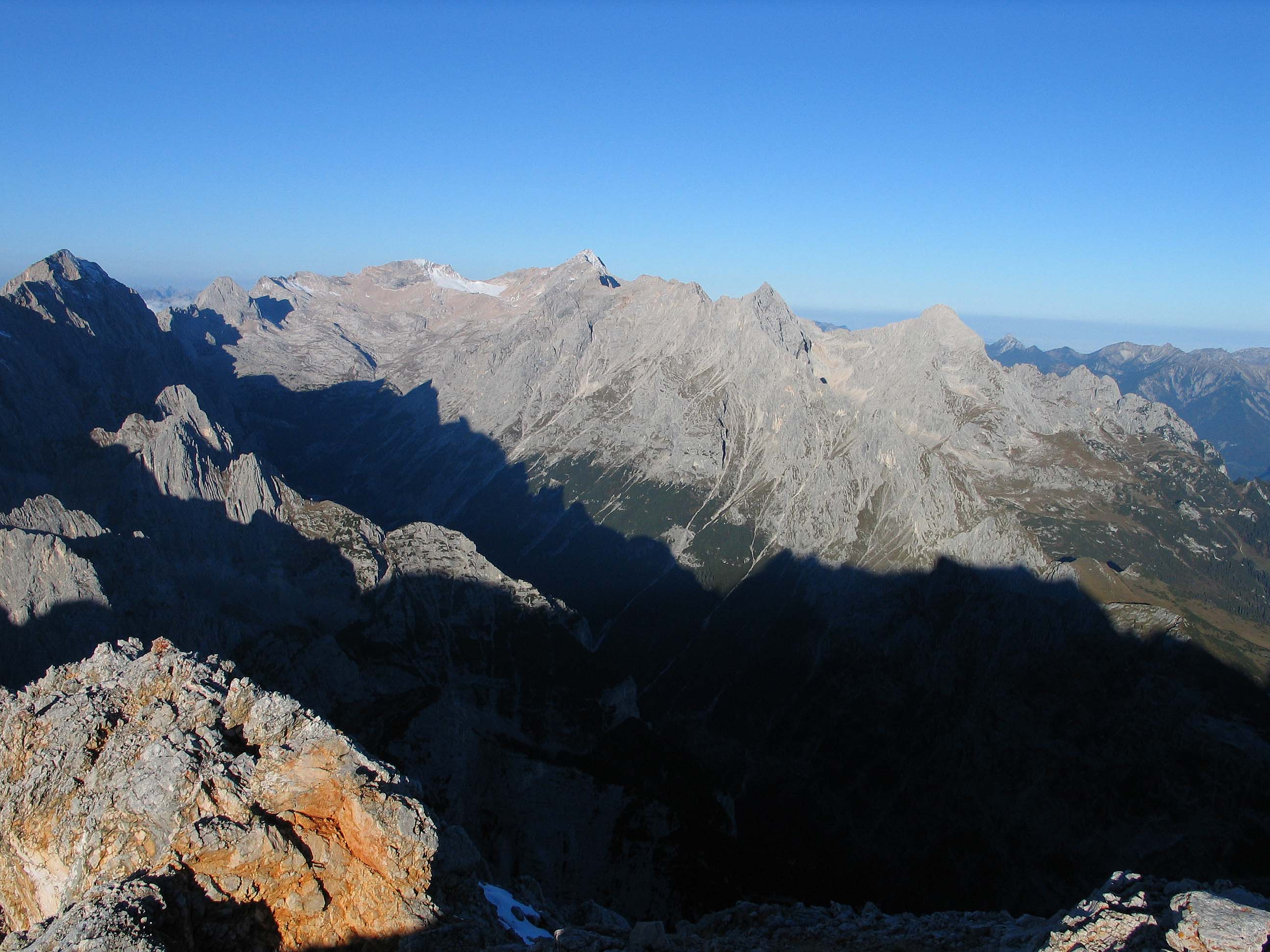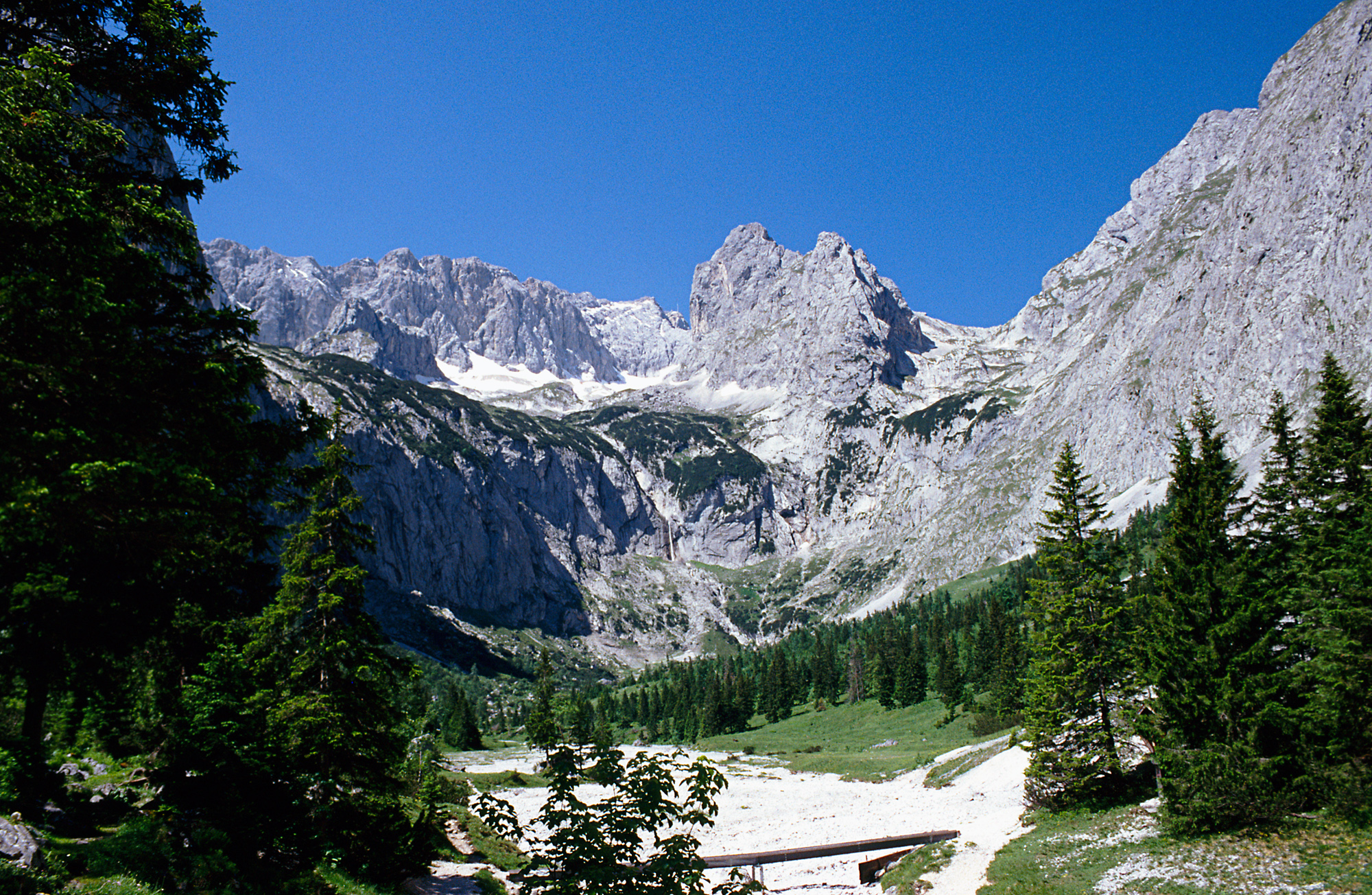|
Riffelwandspitzen
The Riffelwandspitzen are two adjacent mountains in the Wettersteingebirge, Wetterstein range in Bavaria. The summit of the Great Riffelwandspitze () reaches a height of 2,626 m, the summit of the Little Riffelwandspitze (''Kleine Riffelwandspitze'') 2,543 m. Situation The Great and Little Riffelwandspitze are the two most prominent peaks on the short crest of the ''Riffelwandkamm'' that runs from Germany's highest mountain, the Zugspitze, northeast towards the Waxensteinkamm. Its south faces drop steeply into the ''Höllentalkar'' cirque, its north faces plunge into the ''Riffelriß'' above the lake of Eibsee. A knife-edge ridge runs from the Great Riffelwandspitze in a southwesterly direction to the Zugspitze. The ridge of the ''Riffelwandkamm'' joins the Little Riffelwandspitze to the Waxensteinkamm passing over the Riffeltorkopf. A side ridge runs away to the Eastern Riffelkopf (''Östlichen Riffelkopf''), whose east face plummets vertically into the Höllental ( ... [...More Info...] [...Related Items...] OR: [Wikipedia] [Google] [Baidu] |
Wetterstein Mountains
The Wetterstein mountains (), colloquially called Wetterstein, is a mountain group in the Northern Limestone Alps within the Eastern Alps, crossing the Austria–Germany border. It is a comparatively compact range located between Garmisch-Partenkirchen, Mittenwald, Seefeld in Tirol and Ehrwald along the border between Germany (Bavaria) and Austria (Tyrol (state), Tyrol). Zugspitze, the highest peak is at the same time the highest mountain in Germany. The Wetterstein mountains are an ideal region for mountaineers and climbing, climbers. Mountain walkers sometimes need to allow for significant differences in elevation. The proximity of the range to the south German centres of population, the scenic landscape and its good network of Aerial lift, cable cars and lifts mean that the mountains are heavily frequented by tourists for most of the year. There are, however, places in the Wetterstein that are rarely or never visited by people. Neighbouring ranges The Wetterstein ... [...More Info...] [...Related Items...] OR: [Wikipedia] [Google] [Baidu] |
Höllentalanger Hut
The Höllentalanger Hut (1,381 m) is a managed hut owned by the German Alpine Club in the Wetterstein Mountains of Bavaria, in the district of Garmisch-Partenkirchen. The hut lies in a narrow defile between the Höllental-Blassen and Waxenstein-Riffelwand crest and is open from the end of May to mid-October. It has more than 80 bedspaces. Its predecessor, with 80 bedspaces, was demolished in September 2013 in order to make way for an entirely new hut. It was built in 2014/15 and opened on 23 August 2015. History The category 1 hut was built in 1894 and has had its present appearance since 1925 when it was extended. Since 2004 a completely new hut has been in planning. The cost of construction has been assessed by the German Alpine Club at €2.3M. The new hut is intended to take the extreme avalanche situation in the Höllental into account. The winter room was closed by the authorities in 2004 or 2005 due to the avalanche danger in winter. The demolition of the old hut began ... [...More Info...] [...Related Items...] OR: [Wikipedia] [Google] [Baidu] |
Mountains Of The Alps
This page tabulates only the most prominent mountains of the Alps, selected for having a topographic prominence of ''at least'' , all exceeding in height. Although the list contains 537 summits, some significant alpine mountains are necessarily excluded for failing to meet the stringent prominence criterion. The list of these most prominent mountains is continued down to 2500 m elevation at List of prominent mountains of the Alps (2500–2999 m) and down to 2000 m elevation on List of prominent mountains of the Alps (2000–2499 m). All such mountains are located in France, Italy, Switzerland, Liechtenstein, Austria, Germany or Slovenia, even in some lower regions. Together, these lists include all 44 ultra-prominent peaks of the Alps, with 19 ultras over 3000m on this page. For a definitive list of all 82 of the highest peaks of the Alps, as identified by the International Climbing and Mountaineering Federation (UIAA), and often referred to as the 'Alpine four-thousanders' ... [...More Info...] [...Related Items...] OR: [Wikipedia] [Google] [Baidu] |
Mountains Of Bavaria
A mountain is an elevated portion of the Earth's crust, generally with steep sides that show significant exposed bedrock. Although definitions vary, a mountain may differ from a plateau in having a limited summit area, and is usually higher than a hill, typically rising at least above the surrounding land. A few mountains are isolated summits, but most occur in mountain ranges. Mountains are formed through tectonic forces, erosion, or volcanism, which act on time scales of up to tens of millions of years. Once mountain building ceases, mountains are slowly leveled through the action of weathering, through slumping and other forms of mass wasting, as well as through erosion by rivers and glaciers. High elevations on mountains produce colder climates than at sea level at similar latitude. These colder climates strongly affect the ecosystems of mountains: different elevations have different plants and animals. Because of the less hospitable terrain and climate, mountains ... [...More Info...] [...Related Items...] OR: [Wikipedia] [Google] [Baidu] |
Bergverlag Rother
Bergverlag Rother is a German publisher with its headquarters in Oberhaching, Upper Bavaria. Since 1950 the company, that formerly went under the name of ''Bergverlag Rudolf Rother'', had published the Alpine Club Guides in cooperation with the German Alpine Club (DAV), the Austrian Alpine Club (ÖAV) and the South Tyrol Alpine Club. Rother publish a "famous series of English language guides" covering most of the popular walking destinations in the Alps and Europe. History The company was founded on 16 November 1920 in Munich Munich is the capital and most populous city of Bavaria, Germany. As of 30 November 2024, its population was 1,604,384, making it the third-largest city in Germany after Berlin and Hamburg. Munich is the largest city in Germany that is no ... by Rudolf Rother sen., a bookseller and mountaineer, and is one of the oldest and most important specialist Alpine publishers. [...More Info...] [...Related Items...] OR: [Wikipedia] [Google] [Baidu] |
Climbing Grade
Many climbing routes have grades for the technical difficulty, and in some cases for the risks, of the route. The first ascensionist can suggest a grade but it will be amended for the ''consensus view'' of subsequent ascents. While many countries with a tradition of climbing developed their own grading systems, a small number of grading systems have become internationally dominant for each type of climbing, and which has led to the standardization of grading worldwide. Over the years, grades have consistently risen in all forms of climbing, helped by improvements in climbing technique and equipment. In free climbing (i.e. climbing rock routes with no aid), the most popular grading systems are the French numerical or sport system (e.g. f7c+), the American YDS system (e.g. 5.13a), and latterly the UIAA scale (e.g. IX+). These systems grade technical difficulty being the main focus of the lower-risk activity of sport climbing. The American system adds an R/X suffix to tra ... [...More Info...] [...Related Items...] OR: [Wikipedia] [Google] [Baidu] |
Bavarian Zugspitze Railway
The Bavarian Zugspitze Railway () is one of four rack railways still working in Germany, along with the Wendelstein Railway, the Drachenfels Railway and the Stuttgart Rack Railway. The metre gauge line runs from Garmisch in the centre of Garmisch-Partenkirchen to the Zugspitzplatt, approximately 300 metres below Zugspitze, the highest mountain in Germany. The line culminates at 2,650 metres above sea level, which makes it the highest railway in Germany and the third highest in Europe. It is also the railway in Europe with the biggest height difference: , the lower half being open-air and the upper half being underground. The line is operated by the ''Bayerische Zugspitzbahn Bergbahn AG'' (''BZB''), whose majority owner is the Garmisch-Partenkirchen Municipal Works. In 2007 the Zugspitze Railway was nominated for a award. The Zugspitze is accessible via the Seilbahn Zugspitze from Eibsee Lake or Tyrolean Zugspitze Cable Car. History Opening of the line The railway was ... [...More Info...] [...Related Items...] OR: [Wikipedia] [Google] [Baidu] |
Höllental (Bavaria)
Hell Valley or Valley of Hell may refer to: * Höllental (Black Forest), a deep valley in the state of Baden-Württemberg, Germany ** Hell Valley Railway, a line that runs through the valley * Höllental (Franconian Forest), a protected nature reserve in Bavaria, Germany * Höllental (Lower Austria), a valley in the Alps along the River Schwarza * Höllental (Wetterstein), a mountain path up the Zugspitze on the German-Austrian border * Val d'Enfer, a valley in Provence, France * ''The Valley of Hell'' (film), a 1927 American Western * Thermal Valley, Taiwan See also * Heil Valley Heil Valley () is an ice-free valley, long, that indents the northern part of V-shaped Mount Littlepage in the Head Mountains of Victoria Land. Named by the Advisory Committee on Antarctic Names in 2007 after Joseph J. Heil III, supervisor of th ..., Victoria Land, Antarctica * Hill Valley (other) {{Disambiguation, geo ... [...More Info...] [...Related Items...] OR: [Wikipedia] [Google] [Baidu] |
Bavaria
Bavaria, officially the Free State of Bavaria, is a States of Germany, state in the southeast of Germany. With an area of , it is the list of German states by area, largest German state by land area, comprising approximately 1/5 of the total land area of Germany, and with over 13.08 million inhabitants, it is the list of German states by population, second most populous German state, behind only North Rhine-Westphalia; however, due to its large land area, its population density is list of German states by population density, below the German average. Major cities include Munich (its capital and List of cities in Bavaria by population, largest city, which is also the list of cities in Germany by population, third largest city in Germany), Nuremberg, and Augsburg. The history of Bavaria includes its earliest settlement by Iron Age Celts, Celtic tribes, followed by the conquests of the Roman Empire in the 1st century BC, when the territory was incorporated into the provinces of Ra ... [...More Info...] [...Related Items...] OR: [Wikipedia] [Google] [Baidu] |






